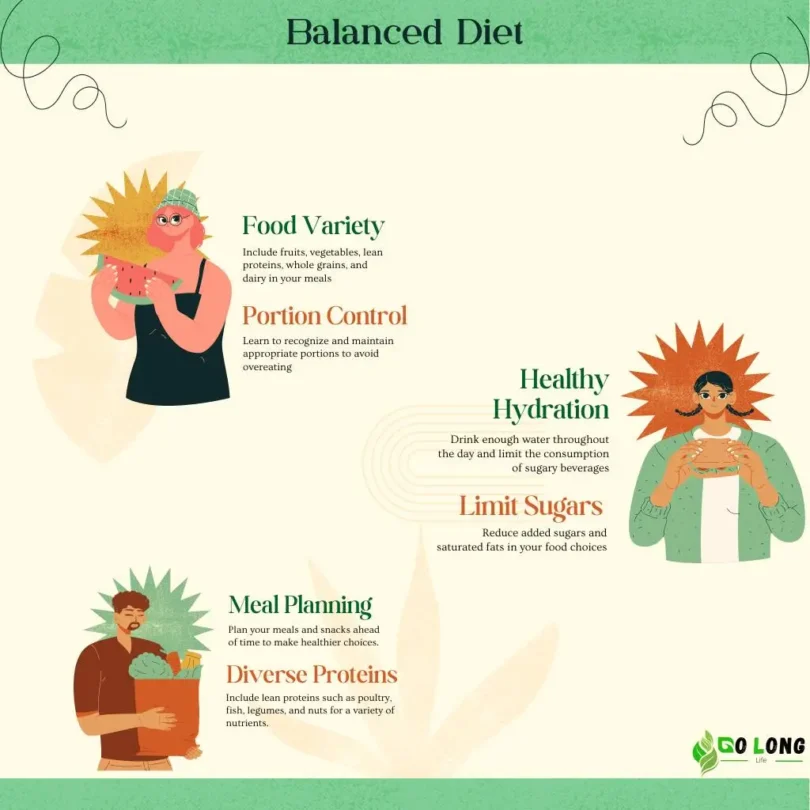Creating a balanced meal plan for a week can seem like a daunting task, but with the right guidance, it can be both simple and rewarding. A well-structured meal plan ensures that you get all the essential nutrients your body needs while saving time and reducing stress during the week. This article will guide you through the steps to create a balanced meal plan, explain the importance of various food groups, and provide tips to make meal planning easier. We’ll also include references to helpful books, articles, and quotes to support the information.
Understanding the Basics of a Balanced Meal Plan
Before diving into meal planning, it’s important to understand what a balanced meal is and why it’s crucial for your health.
What Is a Balanced Meal?
A balanced meal contains a variety of foods that provide the essential nutrients your body needs to function properly. These nutrients include carbohydrates, proteins, fats, vitamins, and minerals. A balanced meal typically consists of:
- Carbohydrates: Provide energy for your body. Sources include whole grains, fruits, and vegetables.
- Proteins: Help build and repair tissues. Sources include meat, fish, eggs, beans, and nuts.
- Fats: Support cell function and provide energy. Healthy fats are found in avocados, nuts, seeds, and olive oil.
- Vitamins and Minerals: Essential for various bodily functions. Found in fruits, vegetables, whole grains, and dairy products.
Why a Balanced Meal Plan Matters
Eating a balanced diet is vital for maintaining good health. It helps prevent chronic diseases, supports mental well-being, and keeps your energy levels stable throughout the day.
- Prevents Nutrient Deficiencies: A balanced meal plan ensures you get all the necessary nutrients, preventing deficiencies that can lead to health problems.
- Supports Weight Management: A well-planned diet can help you maintain a healthy weight by controlling portion sizes and reducing unhealthy food choices.
- Improves Energy Levels: Balanced meals provide the right mix of nutrients to keep your energy levels steady and avoid the peaks and troughs that come from eating too much sugar or processed foods.
Step-by-Step Guide to Creating a Balanced Meal Plan
Creating a meal plan involves a few key steps. By following these, you can ensure that your meal plan is nutritious, varied, and suited to your lifestyle.
Step 1: Assess Your Nutritional Needs
Before planning your meals, it’s important to assess your nutritional needs. This depends on factors such as age, gender, activity level, and any specific health conditions.
- Calculate Caloric Needs: Use an online calculator to estimate your daily caloric needs based on your age, weight, and activity level.
- Consider Macronutrient Ratios: Depending on your goals (e.g., weight loss, muscle gain), adjust the ratios of carbohydrates, proteins, and fats in your diet.
- Factor in Health Conditions: If you have specific health conditions (e.g., diabetes, high blood pressure), your meal plan should accommodate those needs.
Reference:
- “The Complete Guide to Nutrition in Health and Disease” by Bruce A. Watkins – This book provides detailed guidelines on understanding and meeting your nutritional needs based on various health factors.
Step 2: Choose a Variety of Foods
Variety is key to a balanced diet. Incorporating a wide range of foods ensures that you get a diverse array of nutrients.
- Include Different Food Groups: Ensure your meal plan includes fruits, vegetables, whole grains, proteins, and healthy fats.
- Rotate Foods: Avoid eating the same foods every day. Rotate your choices to get a broad spectrum of nutrients.
- Seasonal Produce: Opt for seasonal fruits and vegetables, which are fresher, more nutritious, and often more affordable.
Quote:
- “Let food be thy medicine and medicine be thy food.” – Hippocrates
Step 3: Plan Your Meals and Snacks
Now that you understand your nutritional needs and have chosen a variety of foods, it’s time to plan your meals and snacks for the week.
- Breakfast: Start your day with a balanced breakfast that includes whole grains, proteins, and fruits. For example, oatmeal with berries and nuts, or a smoothie with spinach, banana, and protein powder.
- Lunch: Aim for a mix of lean proteins, whole grains, and vegetables. A chicken and quinoa salad with mixed greens, or a whole grain wrap with turkey and avocado are good options.
- Dinner: Keep dinner light but satisfying. Grilled fish with roasted vegetables and brown rice, or a vegetable stir-fry with tofu are excellent choices.
- Snacks: Plan for healthy snacks to keep you full between meals. Fresh fruit, nuts, yogurt, or hummus with vegetables are nutrient-dense options.
Step 4: Prepare a Shopping List
Once your meals are planned, create a shopping list to ensure you have all the ingredients you need. Organize your list by food groups to make shopping quicker and more efficient.
- Fruits and Vegetables: List both fresh and frozen options to ensure variety throughout the week.
- Proteins: Include a mix of lean meats, fish, eggs, beans, and tofu.
- Whole Grains: Add whole grain bread, brown rice, quinoa, and oats to your list.
- Dairy and Alternatives: Include milk, yogurt, cheese, or plant-based alternatives like almond milk.
Step 5: Meal Prep and Cooking
Meal prep involves preparing ingredients or meals in advance, saving time during the week. Here’s how to get started:
- Batch Cooking: Prepare large batches of grains, proteins, and vegetables that can be used in multiple meals throughout the week.
- Portioning: Divide meals into portions and store them in containers for easy grab-and-go options.
- Freezing: Freeze portions of meals that you won’t eat immediately to maintain freshness.
Reference:
- “Meal Prep: The Ultimate Guide to Healthy Meal Prepping” by Stephanie Tornatore and Adam Bannon – This book offers practical tips and recipes for effective meal prepping.
Tips for Maintaining a Balanced Meal Plan
Maintaining a balanced meal plan requires consistency and flexibility. Here are some tips to help you stay on track.
Stay Hydrated
Hydration is crucial for overall health. Water plays a key role in digestion, nutrient absorption, and energy levels.
- Drink Water Regularly: Aim to drink at least eight glasses of water a day. Keep a water bottle with you to remind you to stay hydrated.
- Incorporate Hydrating Foods: Include foods like cucumbers, watermelon, and oranges in your diet, which are high in water content.
Listen to Your Body
Pay attention to your body’s signals. Hunger, fullness, and cravings are important cues that can guide your eating habits.
- Eat When Hungry: Don’t skip meals or ignore hunger signals. Eating regularly helps maintain energy levels and prevents overeating.
- Stop When Full: Practice mindful eating by paying attention to when you feel full, and avoid eating out of habit or boredom.
- Address Cravings Wisely: If you have a craving, try to satisfy it in a healthy way. For example, if you crave something sweet, opt for a piece of fruit instead of candy.
Quote:
- “Your body will tell you what it needs. All you have to do is listen.” – Louise Hay
Adjust Your Plan as Needed
Your meal plan should be flexible and adaptable to your needs. Life can be unpredictable, so it’s important to adjust your plan when necessary.
- Swap Meals: If you’re not in the mood for a planned meal, feel free to swap it for another meal in your plan.
- Use Leftovers: Don’t let leftovers go to waste. Repurpose them into new meals, such as turning roasted vegetables into a salad or using cooked grains in a stir-fry.
- Eat Out Wisely: If you dine out, choose balanced options that fit within your meal plan. Opt for grilled or baked dishes instead of fried, and ask for dressings and sauces on the side.
References and Resources
Books
- “The Plate Method” by Victor Yalom: This book explains how to create balanced meals using the plate method, a simple visual guide to portioning your meals.
- “Intuitive Eating” by Evelyn Tribole and Elyse Resch: This book offers a non-diet approach to healthy eating, focusing on listening to your body’s signals.
Articles
- “The Power of Portion Control” by Harvard Health Publishing: This article discusses the importance of portion control in maintaining a balanced diet.
- “Healthy Meal Planning: Tips for Busy People” by Mayo Clinic: This article provides practical advice for planning healthy meals, even with a busy schedule.
Quotes
- “A healthy outside starts from the inside.” – Robert Urich
- “The food you eat can be either the safest and most powerful form of medicine or the slowest form of poison.” – Ann Wigmore
Review and Adjust
Finally, review and adjust your plan. At the end of the week, see what worked and what didn’t. Make notes for the next week. Adjust portions or ingredients as needed. This will help improve your meal-planning skills over time.
Creating a balanced weekly meal plan is simple, with the proper steps. Start with a grocery list, plan your meals, and use a template. Prep ahead and stay flexible. Include variety and balance your plate. Remember to keep hydrated. Review and adjust your plan weekly. With these tips, you can enjoy a healthy and stress-free week of eating.
Conclusion
Creating a balanced meal plan for a week doesn’t have to be overwhelming. By understanding your nutritional needs, choosing a variety of foods, and planning your meals ahead of time, you can ensure that your diet is nutritious, satisfying, and enjoyable. Remember to stay hydrated, listen to your body, and be flexible with your plan. With these tips and resources, you’ll be well on your way to maintaining a healthy and balanced diet that supports your overall well-being.
We can guide you on your way to a healthy future. Visit our Blog to learn more.


Leave a Reply